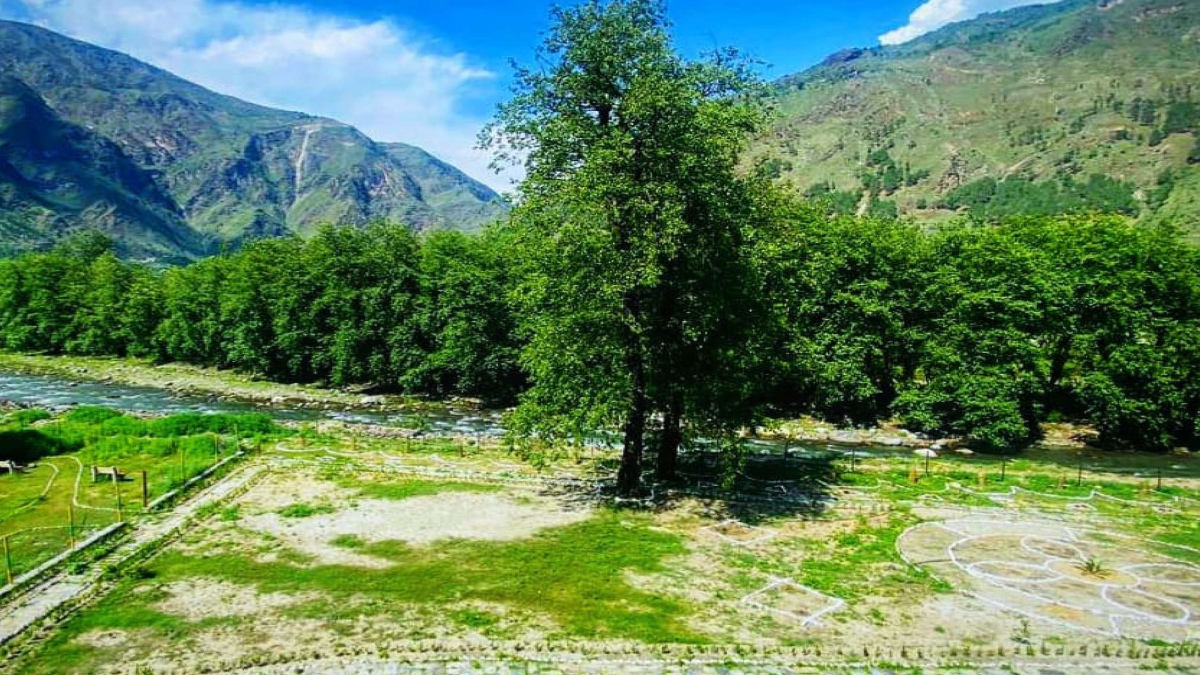
Aishwarya Raj joined the Indian Forest Service in 2017, and Parvati Division was his second posting after Kullu in the state of Himachal Pradesh. Having taken charge in January, 2021, the first task was to assess the ground situation in different areas of his jurisdiction. On one such field visit close to the confluence of the mighty Beas and Parvati rivers, he came across a tract of forest land dumped with garbage and infested with heavy weed overgrowth. This was also a cause of riverside pollution. His staff informed him that the space was being misused by anti-social elements both during day and night to bide their time. These elements were involved in substance abuse as well. There was a threat of encroachment in the near future. Wanting to do something about these challenges, Aishwarya wondered how the forest land could be reclaimed into something safe and how some funds could be sourced to carry out the execution of a plan that he had on his mind. In his previous posting too, he had worked on a 15 hectare wasteland project in Manali that was being developed into an ecotourism project which gave him the confidence to think in terms of a possible revamp here as well.
Interestingly, the Government of Himachal Pradesh, around the same time, declared its intention to set up ‘Swarnim Vatikas’ across the state as part of Himachal’s 50 years statehood celebration. Using this as an opportunity, it was decided to transform this 1 hectare of wasteland into an eco-friendly sprawling, green urban space for town dwellers and nature seekers alike. The green zone was christened as ‘Sangam Swarnim Vatika’ for it stood at the confluence of two mighty rivers. If someone visits the place today, the view is serene, with no evidence of a shabby dump yard that once held ground here. Instead, it has been replaced with a beautifully landscaped garden, with a variety of tree species, creepers, shrubs, herbs along the area, frequented by a variety of beautiful birds.
The first step was to clear the area of its waste pile, cactus and weeds. The enthusiastic forest guards organized the clean-up quite efficiently. The garbage of around 25 tippers was collected and disposed. The organic waste was turned into processing vermicompost in nearby nurseries. The quality of soil was checked by deep digging and it was found to be in fairly good condition for plant growth. After mixing with some fertile mountain soil and humus, the soil was readied.
Before planting, the second step was to ensure the protection of the 2.5 acre area from both grazing/biotic pressures and movement of anti-social elements. In part RCC fencing and inter-link chain fencing was carried out for the entire space. Additionally, CCTV cameras were also installed nearby for monitoring purpose.
Technology cam handy. Aishwarya’s I-pad (which he deployed at workplace to minimize paper use) was a huge help in designing the entire lay-out of the Swarnim Vatika. After spending sometime exploring and reading on the local ecology and plant suitability of the ecotone area (Riverine), species of trees, shrubs and ornamental ones were identified. These could be considered for plantation in the park.
In phase I, over 400 species of native varieties such as deodar, silver oak, horse-chestnut, jacaranda, golden shower, bougainvillea, rose, thuja, cycas, ribbon plant, gladiola, peach, apricot, plum and pomegranate, among others have been planted. More than 200 additional species will be planted by the coming monsoon season. Groves of some of these species have been created so that can be enjoyed by visitors in future.
For landscaping, it was decided to go the up-cycling way in three aspects. One, the discarded or used slates, a stone with which houses are made in the hills, from the neighboring settlement were up-cycled to create the walking trails. The local ‘Dhrub’ grass sprouting in between those slates within 2 months is a sight to behold. Two, only riverside stones were used to landscape and beautify the Vatika. In addition to being eco-friendly, they enhanced the natural riverside view. Three, signages regarding nature awareness and seating are being installed. For this purpose, driftwood, obtained during last monsoon, are being put to use.
Parvati Valley is a hugely popular tourist hotspot with a number of breathtaking destinations. The Vatika, however, was primarily created for the local people who actually didn’t have enough urban walking or recreational avenues. Interestingly, there have been a number of avian visitors at the park – including yellow-billed blue magpie, parakeets, Eurasian hoopoe, barn swallow and doves. There is a likelihood of further increase in the number of such visitors.
The local panchayats, Mahila Mandals as well as youth groups have been engaged in this effort to instill a sense of ownership amongst them. This will help sustain the effort of keeping this area clean and green.
Next up, an attempt is being made to identify more such degraded areas in Parvati jurisdiction that can be converted into green zones. With funds and local support in place, this initiative will help revamp such areas and enrich the environment. The Vatika is an example where the Forest Department under the visionary leadership of a young forest officer, Aishwarya Raj and his committed team demonstrated a win-win scenario of nature conservation and development. Such initiatives, though small and in remote locations, can inspire others to do the same as they attempt to restore the beauty of Mother Earth. It is also an effort to demonstrate that a combination of concern for nature and capability to take the stake holders along can help transform the landscape in many regions. There are indeed many parts of the country that require such interventions















